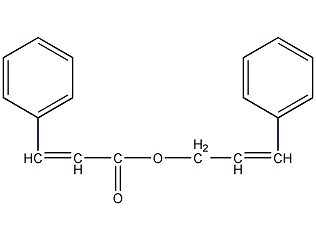Cinnamic acid esters Cinnamic acid esters


Structural formula
| Business number | 03FC |
|---|---|
| Molecular formula | C18H16O2 |
| Molecular weight | 264.32 |
| label |
cinnamyl cinnamate, Cinnamyl cinnamate, artificial flavors |
Numbering system
CAS number:122-69-0
MDL number:MFCD00037826
EINECS number:204-566-1
RTECS number:GD8562000
BRN number:None
PubChem number:24900961
Physical property data
1. Properties: Colorless or white crystals.
2. Melting point (℃): 44
3. Boiling point (normal pressure, ℃): 370
4. Relative density (d4): 1.1565
Toxicological data
1. Acute toxicity: rat oral LD50: 4200mg/kg; rat skin LD50: >5gm/kg.
2. No irritation was found after the product was applied to intact or damaged rabbit skin for 1 day. If a 4% Vaseline preparation was used in a closed skin contact test on humans, no irritation was found after 2 days. Maximum testing in humans has also shown no sensitization reactions.
Ecological data
None yet
Molecular structure data
5. Molecular property data:
1. Molar refractive index: 84.01
2. Molar volume (cm3/mol): 235.7
3. Isotonic specific volume (90.2K): 613.0
4. Surface tension (dyne/cm): 45.7
5. Dielectric constant:
6. Dipole moment (10-24cm3):
7. Polarizability: 33.30
Compute chemical data
1. Hydrophobic parameter calculation reference value (XlogP): 4.4
2. Number of hydrogen bond donors: 0
3. Number of hydrogen bond acceptors: 2
4. Number of rotatable chemical bonds: 6
5. Number of tautomers:
6. Topological molecular polar surface area (TPSA): 26.3
7. Number of heavy atoms: 20
8. Surface charge: 0
9. Complexity: 331
10. Number of isotope atoms: 0
11. Determine the number of atomic stereocenters: 0
12. Uncertain number of atomic stereocenters: 0
13. Determine the number of chemical bond stereocenters Number: 2
14. Number of uncertain chemical bond stereocenters: 0
15. Number of covalent bond units: 1
Properties and stability
- Colorless or white crystals.
- Found in styrax, white Peruvian balm and Honduras balm. This compound has a cinnamon-sweet, mild ointment, floral and spicy aroma. The aroma is heavy and long-lasting. Stable in nature and does not cause discoloration. cis and �A mixture of �� isomers. White or colorless crystals with a slightly sweet resinous aroma. Insoluble in water, soluble in ethanol (1:20), ether and benzene.
Storage method
Keep away from light and in a cool place.
Synthesis method
1. Introduction to production methods
There are two methods for producing diphenylhydrazine from nitrobenzene through reduction. 1. Reduction with zinc powder; 2. Reduction with glucose and silicon powder.
Purpose
For the determination of arabinose and lactose. It has been widely used in flavoring food and daily chemical products more than 80 years ago. Used in trace amounts in fruity food flavors. Soft drinks and candies can use 0.81~10mg/kg. In the preparation of daily chemical fragrances, it is suitable for heavy cinnamon-sweet floral carnation, hyacinth, white orchid, magnolia and tuberose fragrances. It can harmonize with cistus products, patchouli oil, oakmoss or tree moss products. It can also be used as a modification and fixative for sandalwood and orchids. The concentration of this compound used in daily chemical products is 0.01% to 0.1% for soaps; 0.001% to 0.01% for detergents; 0.005% to 0.02% for creams and others; and perfumes. 0.08%~0.4%.
